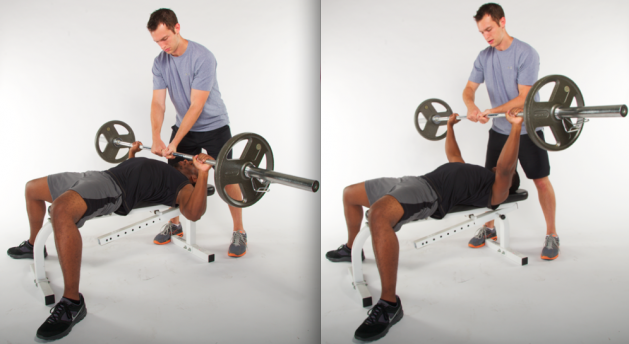Calculating Your One-Rep Max
The goal of any strength training program is to make you stronger. But you can never measure the effectiveness of your workouts unless you test yourself to determine your one-rep max.
Your one-rep max—commonly referred to as 1RM—is the maximum amount of weight you can lift while maintaining perfect form on an exercise. It is used to test core lifts such as the Squat, Bench Press, Deadlift and Olympic lifts. It is not advisable to test your 1RM with isolation exercises like Bicep Curls and Triceps Extensions.
No matter what type of program you’re on, you must show progress. Growth in your 1RM indicates that you are getting better, while providing strong evidence of your work ethic and dedication. (Learn how to set a record one-rep max.)
In addition, max testing allows you to develop a program that effectively challenges your muscles to attain your desired goals. For example, if you are trying to build muscle, you should Bench Press at about 70% of your max. If you are trying to get stronger, you should lift at 90%.
Max Testing Protocols
Testing involves one of two protocols:
Beginners: Athletes new to an exercise can estimate their 1RM by doing a three- to five-rep max test.
Experienced Lifters: Athletes who are familiar with an exercise will perform a true 1RM test.
Testing Conditions
A competent spotter (or spotters) is necessary to ensure safety. A qualified strength and conditioning coach should oversee the test and serve as a judge. The test should be preceded by a thorough warm-up and proper instruction on technique delivered by the coach.
Test Instructions
One-Rep Max (according to the NSCA)
- Perform 5-10 reps with about half of your estimated max
- Rest for 1 minute
- Add 10-20 pounds (lower body) or 30-40 pounds (upper body)
- Perform 3-5 reps
- Rest for 2 minutes
- Repeat step 3 and perform 2-3 reps
- Rest for 2-4 minutes
- Repeat step 3 and attempt a 1 rep max
- If successful, rest for 2-4 minutes and repeat step 8
- If failed, rest for 2-4 minutes, subtract 5-10 pounds (lower body) or 15-20 pounds (upper body) and attempt a max
- Continue until max is found
Sub-Max Testing
Use the same formula as above, but find the max weight that can be performed for three to five reps. Then plug your numbers into the equation below.
Estimated 1RM = Weight Used / (1.0278 – (0.0278 x Number of Repetitions)
For example, if you bench 155 for five repetitions, your estimated max is 174 pounds.
RECOMMENDED FOR YOU
MOST POPULAR
Calculating Your One-Rep Max
The goal of any strength training program is to make you stronger. But you can never measure the effectiveness of your workouts unless you test yourself to determine your one-rep max.
Your one-rep max—commonly referred to as 1RM—is the maximum amount of weight you can lift while maintaining perfect form on an exercise. It is used to test core lifts such as the Squat, Bench Press, Deadlift and Olympic lifts. It is not advisable to test your 1RM with isolation exercises like Bicep Curls and Triceps Extensions.
No matter what type of program you’re on, you must show progress. Growth in your 1RM indicates that you are getting better, while providing strong evidence of your work ethic and dedication. (Learn how to set a record one-rep max.)
In addition, max testing allows you to develop a program that effectively challenges your muscles to attain your desired goals. For example, if you are trying to build muscle, you should Bench Press at about 70% of your max. If you are trying to get stronger, you should lift at 90%.
Max Testing Protocols
Testing involves one of two protocols:
Beginners: Athletes new to an exercise can estimate their 1RM by doing a three- to five-rep max test.
Experienced Lifters: Athletes who are familiar with an exercise will perform a true 1RM test.
Testing Conditions
A competent spotter (or spotters) is necessary to ensure safety. A qualified strength and conditioning coach should oversee the test and serve as a judge. The test should be preceded by a thorough warm-up and proper instruction on technique delivered by the coach.
Test Instructions
One-Rep Max (according to the NSCA)
- Perform 5-10 reps with about half of your estimated max
- Rest for 1 minute
- Add 10-20 pounds (lower body) or 30-40 pounds (upper body)
- Perform 3-5 reps
- Rest for 2 minutes
- Repeat step 3 and perform 2-3 reps
- Rest for 2-4 minutes
- Repeat step 3 and attempt a 1 rep max
- If successful, rest for 2-4 minutes and repeat step 8
- If failed, rest for 2-4 minutes, subtract 5-10 pounds (lower body) or 15-20 pounds (upper body) and attempt a max
- Continue until max is found
Sub-Max Testing
Use the same formula as above, but find the max weight that can be performed for three to five reps. Then plug your numbers into the equation below.
Estimated 1RM = Weight Used / (1.0278 – (0.0278 x Number of Repetitions)
For example, if you bench 155 for five repetitions, your estimated max is 174 pounds.











